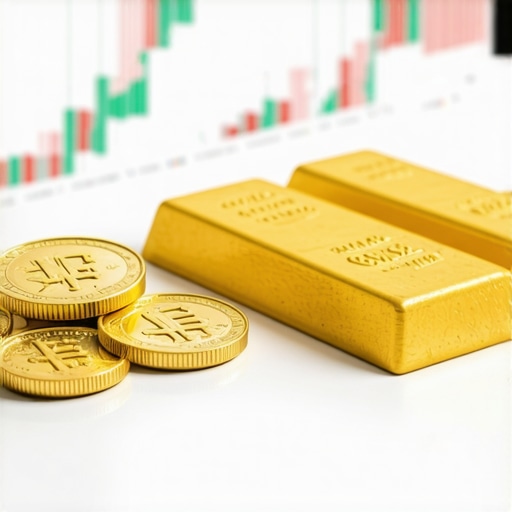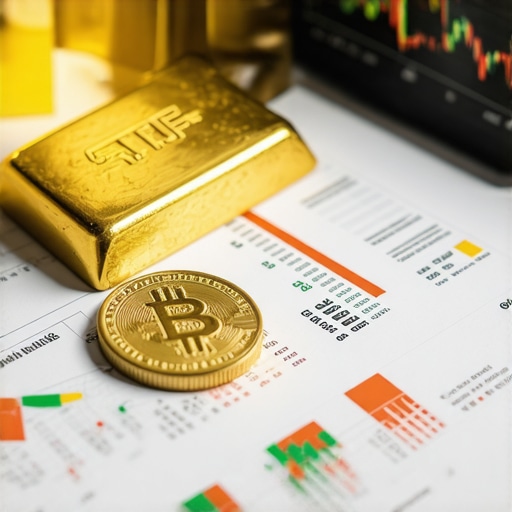Unlocking the Golden Spectrum: Diverse Avenues of Gold Investment
Gold has long been a beacon of financial security and wealth preservation. For beginners stepping into the world of gold investments, understanding the various types available is crucial to crafting a resilient portfolio. This guide demystifies the main forms of gold investments, revealing their unique characteristics and strategic advantages.
Physical Gold: Tangible Wealth in Your Hands
Investing in physical gold means owning real gold in the form of bars, coins, or bullion. This traditional approach offers a palpable sense of security as investors hold an asset with intrinsic value. However, it requires considerations such as secure storage and insurance. Notable examples include sovereign gold coins and kilo bars, prized for their purity and liquidity.
Gold ETFs and Mutual Funds: Bridging Convenience and Exposure
For those seeking exposure to gold without handling physical assets, gold Exchange-Traded Funds (ETFs) and mutual funds present a compelling alternative. These instruments track gold prices or invest in gold-related assets, providing liquidity and ease of trading on stock exchanges. They also offer diversification within the gold sector, mitigating risks tied to physical ownership. To dive deeper into selecting suitable funds, explore comprehensive resources on choosing the right gold ETFs and mutual funds.
Gold Mining Stocks: Capitalizing on Production and Growth
Another avenue is investing in gold mining companies. These stocks offer exposure to gold prices plus the potential for dividends and capital appreciation driven by operational success. However, they carry additional risks such as management effectiveness and geopolitical factors. Understanding these nuances is essential before committing capital. For expert insights, see our detailed analysis on investing in gold mining stocks.
Futures and Options: Navigating Gold’s Volatility with Leverage
More sophisticated investors might explore gold futures and options, which are contracts to buy or sell gold at predetermined prices in the future. These instruments enable hedging against price fluctuations or speculative trading with leverage. While potentially lucrative, they require a solid understanding of market dynamics and risk management. For a beginner-friendly introduction, consider reading the ultimate guide to gold futures trading.
How Do I Choose the Right Type of Gold Investment for My Financial Goals?
Choosing the ideal gold investment depends on your risk tolerance, liquidity needs, investment horizon, and market knowledge. Physical gold suits those valuing tangible assets and long-term security. ETFs and mutual funds offer ease and diversification without storage hassles. Mining stocks can enhance returns but add company-specific risks. Futures and options are for those comfortable with active trading and leverage. Balancing these factors with your financial objectives will guide your selection effectively.
Gold investment strategies can significantly benefit from understanding market drivers and expert insights. For a broader perspective on various gold investments, explore our comprehensive resource on types of gold investments.
We invite you to share your experiences or questions about gold investing in the comments below to foster a community of informed investors.
According to the World Gold Council, gold remains a critical asset for portfolio diversification and inflation hedging, underscoring its enduring value in modern investment strategies (source).
Balancing Act: Combining Different Gold Investment Forms for a Robust Portfolio
From my experience, relying on just one type of gold investment rarely maximizes benefits. Early on, I leaned heavily on physical gold because it felt like the most secure option — there’s something reassuring about holding tangible bars or coins. But over time, I realized diversification within gold investments could enhance both liquidity and growth potential.
I started blending physical gold with ETFs, which allowed me to keep some gold exposure without worrying about storage or security. ETFs gave me the flexibility to react quickly to market changes, which physical gold doesn’t easily allow. At the same time, I cautiously dipped into gold mining stocks, attracted by their potential dividends and growth, but mindful of the operational and geopolitical risks involved.
If you’re curious about integrating multiple gold investment types effectively, you might find this smart gold investment strategies guide quite insightful. It helped me refine my approach by balancing risk and rewards, tailoring a strategy that fits personal goals and market conditions.
Why Market Timing Matters More Than You Think in Gold Investing
I’ve learned the hard way that timing your gold purchases and sales can significantly influence your returns. Unlike some investments where dollar-cost averaging can smooth out volatility, gold’s price can be heavily swayed by macroeconomic events, central bank policies, and even geopolitical tensions.
For example, during periods of heightened inflation fears, gold prices often spike as investors flock to this safe haven. Conversely, when confidence in fiat currencies strengthens, gold might dip temporarily. Keeping an eye on these drivers, as highlighted in reports from the World Gold Council, can help you make more informed decisions about when to enter or exit the market.
Have you ever struggled with deciding when to buy or sell gold? What factors influenced your timing?
Engaging with fellow investors about their timing strategies can reveal valuable perspectives. I encourage you to share your experiences or questions in the comments below — it’s amazing how collective insights can sharpen our investment instincts.
Practical Considerations: Storage, Security, and Costs
One aspect that often surprises newcomers is the cost and logistics of storing physical gold safely. When I first bought gold bars, I underestimated how critical secure storage would be. Options range from home safes to bank safety deposit boxes or professional vault services. Each comes with trade-offs in accessibility, cost, and peace of mind.
Additionally, buying physical gold involves premiums above the spot price, which vary by type, weight, and dealer. It’s worthwhile to research trusted dealers carefully and understand these nuances to avoid overpaying. If you want a thorough overview of safe purchasing practices, take a look at our detailed guide on buying gold safely online.
In contrast, ETFs and mining stocks remove storage worries but introduce other risks, like market volatility and company-specific challenges. Each choice has its place depending on your comfort level and investment priorities.
Embracing Gold Futures: A Step Into Sophistication
Though I started cautiously, gold futures eventually caught my attention as a way to leverage market movements. They’re not for everyone, given their complexity and risk profile, but for those willing to learn, futures can offer impressive profit potential and portfolio hedging.
If you’re intrigued by this, the ultimate guide to gold futures trading is a fantastic resource. It breaks down the basics clearly and helps newcomers navigate the complexities.
Strategic Synergy: Leveraging Multi-Modal Gold Investments for Optimal Portfolio Performance
To truly harness gold’s potential, a sophisticated investor must go beyond mere allocation and delve into the interplay among different gold investment forms. Physical gold offers a non-counterparty asset that acts as a ballast during systemic shocks, while gold ETFs provide agility and immediate market access. Meanwhile, mining stocks introduce an equity dimension with growth and dividend possibilities, albeit with company-specific and operational risk layers. Futures and options, albeit complex, can be tactically employed to hedge or speculate, amplifying returns but requiring vigilant risk controls.
By integrating these instruments, you create a dynamic portfolio that capitalizes on gold’s diverse characteristics: stability, liquidity, growth potential, and leverage. For instance, pairing physical gold as a defensive core with selective exposure to mining equities can yield balanced growth and protection. Additionally, tactical use of futures can mitigate downside risk during volatile market phases.
What Are the Advanced Risk Management Techniques for Combining Gold Investments?
Effective risk management when combining various gold assets involves meticulous correlation analysis, volatility assessment, and position sizing. Employing tools such as Value at Risk (VaR) and stress testing can illuminate portfolio vulnerabilities under scenarios like sudden gold price shocks or geopolitical crises. Diversifying across geographies and mining company profiles further cushions against idiosyncratic risks.
Moreover, leveraging options strategies like protective puts or covered calls can safeguard downside while generating income, a nuanced approach often overlooked in beginner strategies. Algorithmic trading models and technical indicators also assist in timing entries and exits across different gold instruments, aligning with broader macroeconomic signals.
For a deep dive into these sophisticated risk management frameworks, the World Gold Council’s research on gold in portfolio diversification offers invaluable guidance grounded in empirical data and expert analysis.
Decoding Macroeconomic Signals: How Global Trends Sculpt Gold’s Trajectory
Gold’s price dynamics are intricately linked to a web of macroeconomic variables: real interest rates, inflation expectations, currency fluctuations, and geopolitical tensions. Savvy investors decode these signals not just to forecast price movements but to calibrate their exposure across gold investment types.
For example, rising inflation coupled with low or negative real yields historically propels gold prices upward, bolstering physical gold and ETFs. Conversely, surges in the U.S. dollar often pressure gold prices downward, affecting mining stocks and futures differently due to operational costs and leverage. Geopolitical unrest may prompt flight-to-safety buying, augmenting demand for physical gold and ETFs, whereas mining stocks might see volatility from supply chain disruptions.
Understanding these nuances enables investors to tactically rebalance portfolios — perhaps increasing physical gold during inflationary spikes or trimming mining equities amid geopolitical uncertainties. Monitoring central bank gold purchasing trends and global gold demand-supply fundamentals also refines timing strategies for entry and exit points.
How Can Investors Integrate Macroeconomic Analysis into Gold Investment Decisions?
Integrating macroeconomic analysis involves a blend of fundamental research and quantitative metrics. Investors track key indicators such as the Consumer Price Index (CPI), Producer Price Index (PPI), real interest rates (nominal rates minus inflation), and currency indices. Coupling this data with sentiment analysis and geopolitical risk assessment paints a comprehensive picture.
Tools like econometric models and scenario analysis help simulate potential impacts on gold price trajectories, guiding allocation adjustments. Additionally, subscribing to specialized financial research platforms that focus on commodity markets enhances the depth and timeliness of insights.
For those seeking to elevate their macroeconomic acumen in gold investing, the Investopedia analysis on macroeconomic factors affecting gold prices is an authoritative resource synthesizing theory with market realities.
Technology and Innovation: The Emerging Frontiers in Gold Investment
The digital age is transforming gold investment avenues beyond traditional paradigms. Blockchain-enabled gold tokens, digital gold accounts, and decentralized finance (DeFi) platforms offer fractional ownership, instant liquidity, and transparent provenance. These innovations democratize access to gold investments, reduce transaction costs, and enhance security.
However, they also introduce new challenges such as regulatory uncertainties, counterparty risks, and cybersecurity concerns. Evaluating the credibility of digital gold providers, understanding smart contract mechanics, and assessing custodial solutions become critical competencies.
Early adopters of these technologies can benefit from enhanced flexibility and novel hedging strategies, integrating digital gold assets alongside physical and paper gold holdings for a truly diversified and future-ready portfolio.
Is Digital Gold a Safe and Viable Addition to Traditional Gold Portfolios?
Digital gold platforms typically back tokens with physical gold stored in secure vaults, offering convenience and liquidity. Nevertheless, the safety of these investments hinges on the transparency of asset backing, regulatory compliance, and technological robustness. Investors should conduct due diligence on platform audits, insurance coverage, and redemption policies.
As these platforms mature, they are gaining institutional acceptance, but cautious participation and incremental allocation remain prudent. Keeping abreast of regulatory developments and technological advances ensures you leverage digital gold innovations without undue risk.
For a comprehensive evaluation of digital gold’s promise and pitfalls, the World Gold Council’s report on digital gold offers expert perspectives.
Curious about integrating these advanced strategies into your gold portfolio? Explore our expert-led courses and personalized advisory services to elevate your investment approach.

Quantum Analytics in Gold Market Forecasting: A New Dawn for Investors
The integration of quantum computing and advanced analytics is poised to redefine how investors forecast gold price movements. By leveraging quantum algorithms to process vast datasets encompassing macroeconomic indicators, geopolitical events, and market sentiment, quantum analytics can uncover patterns and correlations imperceptible to classical models. This transformative approach enhances predictive accuracy, enabling portfolio managers to optimize allocation timing and hedge strategies with unprecedented precision.
Artificial Intelligence-Driven Portfolio Optimization: Crafting Adaptive Gold Investment Models
Artificial intelligence (AI) now plays a pivotal role in dynamically adjusting gold investment portfolios in response to evolving market conditions. Machine learning models ingest real-time data streams—ranging from inflation metrics to currency fluctuations—to recalibrate exposure across physical gold, ETFs, mining equities, and derivatives. These adaptive frameworks mitigate risk by anticipating volatility spikes and capitalizing on emergent opportunities, thus fostering resilience and growth.
How Can AI and Quantum Computing Synergize to Enhance Gold Investment Decision-Making?
The convergence of AI and quantum computing facilitates a symbiotic relationship where quantum processors accelerate complex optimization problems while AI algorithms interpret and act upon the outputs. For gold investors, this means faster scenario analysis, enhanced risk assessment, and improved timing strategies. The ability to simulate multifactor economic scenarios and their impact on diverse gold instruments empowers investors to devise robust, multi-modal investment plans that dynamically align with global market shifts.
For rigorous insights into these cutting-edge technologies, the World Gold Council’s research on technology and innovation in gold investment offers authoritative, data-driven perspectives.
Elevating Hedging Techniques with Blockchain-Enabled Smart Contracts
Blockchain technology introduces programmable smart contracts that automate and enforce hedging strategies within gold portfolios. These contracts can trigger predefined actions—such as executing options or futures trades—based on market conditions, reducing latency and human error. This mechanization enhances transparency and auditability while enabling sophisticated risk management tactics tailored to individual investor profiles.
Incorporating ESG Metrics into Gold Investment Frameworks: The Ethical Frontier
Environmental, Social, and Governance (ESG) considerations increasingly influence gold investment decisions, especially concerning mining stocks. Advanced investors integrate ESG scoring into their evaluation models to identify companies demonstrating sustainable practices and social responsibility. This approach not only aligns portfolios with ethical standards but also anticipates regulatory shifts and reputational risks that could materially impact long-term returns.
What Are the Best Practices for Integrating ESG Factors in Gold Mining Stock Selection?
Effective ESG integration involves comprehensive due diligence encompassing carbon footprint assessments, labor rights audits, and governance transparency evaluations. Utilizing third-party ESG rating agencies and engaging in active shareholder advocacy further ensures alignment with sustainability objectives. Balancing these factors with financial metrics helps construct resilient gold mining equity portfolios that can withstand evolving market and regulatory landscapes.
To deepen your understanding, consult the Sustainalytics detailed guide on ESG in gold mining, a reputable source for best practices and case studies.
Call to Action: Embrace the Future of Gold Investing with Advanced Tools and Strategies
As the gold investment ecosystem evolves amidst technological innovation and shifting global dynamics, staying ahead requires embracing sophisticated methodologies. We invite serious investors to explore our advanced analytics workshops and personalized advisory services designed to integrate quantum analytics, AI, blockchain, and ESG frameworks into your gold investment strategy. Engage with our expert team to transform your portfolio into a future-ready, resilient powerhouse.
Frequently Asked Questions (FAQ)
What are the main advantages of investing in physical gold compared to gold ETFs?
Physical gold offers tangible ownership and acts as a non-counterparty asset that can serve as a hedge during systemic financial crises. It provides intrinsic value and long-term security but requires secure storage and incurs premiums and insurance costs. Gold ETFs, by contrast, offer liquidity, ease of trading, and no storage concerns, but investors rely on the fund’s custodianship and market infrastructure.
How do gold mining stocks differ in risk and return profile from direct gold investments?
Gold mining stocks provide exposure to both gold price movements and company-specific factors such as operational efficiency, management quality, and geopolitical risks. They can yield dividends and capital appreciation but are more volatile than physical gold or ETFs. Mining equities are subject to equity market fluctuations and supply chain challenges, requiring careful due diligence.
What level of knowledge is required before trading gold futures and options?
Trading gold futures and options demands an advanced understanding of derivatives, leverage, and market mechanics. Investors must be proficient in risk management techniques, margin requirements, and the implications of contract specifications. These instruments are suitable for sophisticated investors aiming to hedge or speculate and are not recommended for beginners without proper education.
How can macroeconomic factors influence gold investment decisions?
Macroeconomic variables such as inflation rates, real interest rates, currency strength, and geopolitical tensions significantly impact gold prices. For example, rising inflation and negative real yields typically boost gold demand, while a strong U.S. dollar can suppress prices. Understanding these signals helps investors optimize timing and allocation across different gold investment vehicles.
Is digital gold a secure and effective complement to traditional gold holdings?
Digital gold platforms provide fractional ownership backed by physical gold, enhancing liquidity and accessibility. However, safety depends on transparent asset backing, regulatory compliance, and cybersecurity measures. While offering convenience, digital gold should complement—not replace—physical or paper gold investments until regulatory frameworks mature and platforms prove reliable.
What are best practices for integrating ESG criteria into gold mining stock portfolios?
Incorporating ESG involves evaluating environmental impact, social responsibility, and governance standards of mining companies. Using third-party ESG ratings, conducting thorough audits, and engaging in shareholder advocacy helps identify sustainable firms. Aligning ESG with financial metrics mitigates reputational and regulatory risks, supporting long-term portfolio resilience.
How do AI and quantum computing improve gold investment strategies?
AI algorithms analyze real-time market data to adapt portfolio allocations dynamically, anticipating volatility and seizing opportunities. Quantum computing accelerates complex scenario modeling and risk assessments beyond classical capabilities. Together, they enhance predictive accuracy, optimize timing, and enable sophisticated multi-modal gold investment approaches.
What risk management techniques are recommended when combining various gold investment forms?
Effective risk management includes diversification across asset types and geographies, correlation and volatility analysis, position sizing, and stress testing. Employing options strategies like protective puts and algorithmic trading models can further safeguard portfolios. Continuous monitoring and adjustment based on market signals are essential to balance growth and downside protection.
How can investors effectively time gold market entries and exits?
Timing involves monitoring macroeconomic indicators, geopolitical developments, central bank activities, and gold demand-supply fundamentals. Utilizing technical analysis and sentiment metrics can refine entry and exit points. Staying informed through authoritative research and maintaining flexibility to adjust allocations helps capitalize on market cycles.
What storage options exist for physical gold, and what are their trade-offs?
Storage choices range from home safes to bank safety deposit boxes and professional vault services. Home storage offers immediate access but higher security risks; bank vaults provide robust security with limited accessibility; professional vaults balance security and convenience but at a cost. Insurance and trusted dealers are critical considerations to protect physical assets.
Trusted External Sources
- World Gold Council (gold.org): Provides comprehensive research on gold demand trends, portfolio diversification, digital gold innovations, and technology impacts, serving as an authoritative reference for market data and investment insights.
- Investopedia (investopedia.com): Offers in-depth analyses and educational content on macroeconomic factors affecting gold prices and derivatives trading, supporting investors in understanding complex financial instruments.
- Sustainalytics (sustainalytics.com): Specializes in ESG research and ratings, particularly for gold mining companies, guiding investors on integrating sustainability criteria into portfolio selection.
- Commodity Futures Trading Commission (CFTC) Reports: Provides regulatory data and market transparency information crucial for futures and options traders to understand market dynamics and compliance.
- MIT Technology Review (technologyreview.com): Covers emerging technologies such as quantum computing and AI applications in finance, relevant for investors leveraging advanced analytics in gold markets.
Conclusion
Gold remains a multifaceted asset class offering diverse investment avenues—from tangible physical holdings and liquid ETFs to equity stakes in mining companies, sophisticated derivatives, and cutting-edge digital innovations. Each form presents distinct risk-return profiles and operational considerations, underscoring the importance of aligning choices with individual financial goals, risk appetite, and market acumen.
Incorporating macroeconomic analysis, ESG factors, and emerging technologies such as AI and quantum computing elevates the strategic potential of gold investments, enabling adaptive portfolio optimization and nuanced risk management. Embracing a multi-modal approach that synergizes these elements fosters resilience and capitalizes on gold’s unique attributes amid evolving global dynamics.
We encourage readers to apply these expert insights, explore our advanced resources, and engage with the community to refine their gold investment strategies. Share your thoughts, ask questions, and join the conversation to unlock the full potential of gold as a cornerstone of a future-ready portfolio.










This comprehensive overview of the different gold investment options really resonated with my experiences. I’ve personally started with physical gold, mainly because of its tangibility and security. However, I soon realized the importance of diversification, especially incorporating ETFs and mining stocks for more liquidity and growth potential. The section on advanced tools like AI and quantum computing was fascinating — I haven’t explored these areas yet, but it seems promising for future strategies. The emphasis on risk management techniques, such as stress testing and hedging with options, is crucial, especially given gold’s sensitivity to macroeconomic factors. One challenge I’ve faced is timing the market; sometimes, even with all the analysis, making the right buy or sell decisions has been tough. How do others here approach market timing, especially during volatile periods? Sharing insights on this could help us all make smarter moves and build more resilient portfolios.